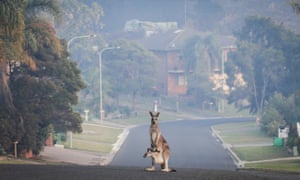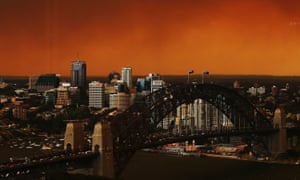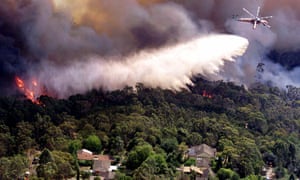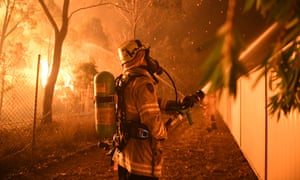Extract from The Guardian
Hotter, drier summers in Australia mean longer fire seasons – and urban sprawl into bushland is putting more people at risk
At first the smoke on the horizon “didn’t look like anything major,”
says Joe Mercieca of that day in 2013. But then the wind picked up.
His house in the Blue Mountains, an hour and a half out of Sydney, was soon surrounded by the blaze. “I told my wife it was too late, let’s retreat,” he says. Mercieca, Merylese and their dog took shelter in the concrete fire bunker they had built beneath their house. “We sat in there and listened to everything explode.”
Overall, more than 200 houses were lost in the fire. The Merciecas lost four vehicles and their home office, destroyed when a flaming truck crashed into it. In the five years since, Mercieca has used his construction business to educate people about the importance of fire preparedness in their homes.
In the past, bushfire season – the period of heightened risk declared by state-specific authorities, often accompanied by fire bans – has typically begun in New South Wales in October and run until March. But an unusual period of months of exceptionally warm and extremely dry weather this year has prompted authorities to start the season early. Not only is Australia’s increasingly hotter, drier weather a cause for concern, but the country’s rapid urbanisation means more people are at risk than ever before.

His house in the Blue Mountains, an hour and a half out of Sydney, was soon surrounded by the blaze. “I told my wife it was too late, let’s retreat,” he says. Mercieca, Merylese and their dog took shelter in the concrete fire bunker they had built beneath their house. “We sat in there and listened to everything explode.”
Overall, more than 200 houses were lost in the fire. The Merciecas lost four vehicles and their home office, destroyed when a flaming truck crashed into it. In the five years since, Mercieca has used his construction business to educate people about the importance of fire preparedness in their homes.
In the past, bushfire season – the period of heightened risk declared by state-specific authorities, often accompanied by fire bans – has typically begun in New South Wales in October and run until March. But an unusual period of months of exceptionally warm and extremely dry weather this year has prompted authorities to start the season early. Not only is Australia’s increasingly hotter, drier weather a cause for concern, but the country’s rapid urbanisation means more people are at risk than ever before.

For large areas in the north and west, bushfire season has been brought forward a whole two months to August – well into winter, which officially began 1 June. The rest of the state, including Sydney, will follow suit from 1 September, closer to spring but still four weeks earlier than usual.
The decision has already been justified. On the first weekend of August, a fire broke out at Doyalson on the NSW Central Coast, just north of Sydney, that crews had to fight to control. Two days later there were 11 uncontained fires in the state.
Rob Rogers, deputy commissioner of the NSW Rural Fire Service, notes that last season fire crews were battling blazes as late as April. “That’s not really bushfire season, and yet we had a big fire on the outskirts of Sydney,” he says.
"If you look at Spain, everyone has white houses. It’s ridiculous that here it’s a trend to have a black roof"
According to the Australian Bureau of Meteorology (Bom), the January to July period 2018 was the warmest in NSW since 1910. Rogers linked these “unseasonably warm temperatures” with the deadly heatwaves in Greece and North America. “It’s fair to say that the climate is changing and longer fire seasons are something we’re starting to experience.”
Bushfires mostly threaten the bushland and national parks surrounding Australian cities, but as their limits edge ever-outwards – the country has one of the highest rates of sprawl in the world – urban areas are increasingly under threat. One of the late-season fires in NSW in April was in Holsworthy, a suburb 30km south-west of inner-city Sydney, forcing the evacuation of hundreds of people and sleepless nights for many more.
Even when not threatened by fire, western Sydney is known to be one of the hottest parts of the entire state of NSW. The area consistently reaches far higher temperatures than the eastern Sydney suburbs because of its unique geography and lack of sea breeze, which combine to create an urban heat island within an urban heat island.

In
January this year Penrith – a major metropolitan area 50km west of the
city centre – was the hottest place on Earth, reaching 47.3C while
Sydney itself was 44C. Annually there are 14 heat-related deaths per 100,000 people in western Sydney, compared with five by the coast. The number of days above 35C a year is projected to increase by five to ten by 2030, while a recent study has predicted that summer heatwaves in major Australian cities are likely to reach highs of 50C by 2040.
Linden Ashcroft, a climate researcher at Bom, says the temperature difference between coastal and western Sydney can be massive and deadly. “The hot days are really dramatic and potentially really dangerous, but it’s the nights that are the real concern.
“If you think of an elderly person or vulnerable member of the community, they struggle through the day generally but then the nights should bring relief. If you’re getting that [urban heat island] effect, you don’t.”
Eight agencies in the western Sydney region have been working together to bring down temperatures through measures including tree-planting, installing air conditioning in public facilities, such as libraries and increasing opening hours for swimming pools in summer.
Stephen Bali, the mayor of Blacktown city council and president of the Western Sydney Regional Organisation of Councils, says there is a wider problem with the way Australian homes are built – typically with dark colours that absorb heat and without features that reduce the need for heating and cooling, such as double-glazed windows and double brick facades.
New homes being built in bushfire-prone areas must meet stringent building requirements, such as stronger glass with some ability to withstand heat and non-combustible features. But Bali says councils need the backing of state governments to mandate materials that are better suited to the Australian climate more broadly.
"We may run into a situation where we exhaust our capacity to fight major fires and we have to rethink the way we live"
“We need to look at building codes. If you look at Spain, everyone has white houses. It’s ridiculous that here it’s a trend to have a black roof.”
Andy Pitman, director of the ARC Centre of Excellence for Climate Extremes at the University of NSW, agrees. “We design almost all our developments perfectly wrong for keeping cities cool,” he says. “Have you ever been to the Mediterranean? Build our houses like that.”
“They are well insulated. They have brightly coloured roofs to reflect sunlight. They don’t need a lot of cooling in summer, and they don’t need a lot of heating in winter.”
Australia’s rapid population growth, focused on its major cities, poses another challenge. Western Sydney is projected to absorb two-thirds of the 1.7m extra people expected in the city by 2036.
Not only will greater population density exacerbate the urban heat island effect, the state’s Office of Environment and Heritage has predicted that the conversion of areas in the north-west and south-west of Sydney from forest and grasslands to new urban development may double the projected temperature increases from climate change in the near future.

Linden Ashcroft, a climate researcher at Bom, says the temperature difference between coastal and western Sydney can be massive and deadly. “The hot days are really dramatic and potentially really dangerous, but it’s the nights that are the real concern.
“If you think of an elderly person or vulnerable member of the community, they struggle through the day generally but then the nights should bring relief. If you’re getting that [urban heat island] effect, you don’t.”
Eight agencies in the western Sydney region have been working together to bring down temperatures through measures including tree-planting, installing air conditioning in public facilities, such as libraries and increasing opening hours for swimming pools in summer.
Stephen Bali, the mayor of Blacktown city council and president of the Western Sydney Regional Organisation of Councils, says there is a wider problem with the way Australian homes are built – typically with dark colours that absorb heat and without features that reduce the need for heating and cooling, such as double-glazed windows and double brick facades.
New homes being built in bushfire-prone areas must meet stringent building requirements, such as stronger glass with some ability to withstand heat and non-combustible features. But Bali says councils need the backing of state governments to mandate materials that are better suited to the Australian climate more broadly.
"We may run into a situation where we exhaust our capacity to fight major fires and we have to rethink the way we live"
“We need to look at building codes. If you look at Spain, everyone has white houses. It’s ridiculous that here it’s a trend to have a black roof.”
Andy Pitman, director of the ARC Centre of Excellence for Climate Extremes at the University of NSW, agrees. “We design almost all our developments perfectly wrong for keeping cities cool,” he says. “Have you ever been to the Mediterranean? Build our houses like that.”
“They are well insulated. They have brightly coloured roofs to reflect sunlight. They don’t need a lot of cooling in summer, and they don’t need a lot of heating in winter.”
Australia’s rapid population growth, focused on its major cities, poses another challenge. Western Sydney is projected to absorb two-thirds of the 1.7m extra people expected in the city by 2036.
Not only will greater population density exacerbate the urban heat island effect, the state’s Office of Environment and Heritage has predicted that the conversion of areas in the north-west and south-west of Sydney from forest and grasslands to new urban development may double the projected temperature increases from climate change in the near future.

As urban areas from Darwin to Melbourne sprawl outwards in hotter, drier summers, the scene is set for a potentially catastrophic combination. “People cause fires,” says Ross Bradstock, the director of the centre for environmental risk management of bushfires at the University of Wollongong. “When you’ve got high densities of populations you can get lots of ignitions, either from people lighting fires directly or from things like power lines for transport.” There are strong indications that conditions conducive to major fires will increase with the changing climate, Bradstock adds.
Earlier starts and later finishes to bushfire season also mean authorities have less time in which to try to reduce the risk through controlled burns. “Sydney is surrounded by bush and a lot of it goes into the suburbs themselves,” says Rogers. “We’ve been trying to do burn-offs and reduce the fuel ahead of summer but in Sydney that’s challenging because people get concerned about the amount of smoke– we haven’t done as much as we’d like.”
Bradstock and his team have been using technology including satellite data and forecasting to pinpoint critically dry areas around Australian cities on a day-to-day basis, and predict that more than half a million houses are now directly exposed to bushfire risk.
Heatwaves are already the country’s deadliest natural disaster, with climatologists warning that they will only increase in frequency, severity and duration. Even Australian cities – better acclimatised to heat than many in the world – must adapt to the changing climate. Bradstock says that could include evaluating how close homes are built to bushland. If major fires become more frequent, as looks likely, “we may run into a situation where we exhaust our capacity to fight them and we have to rethink the way we live”.

No comments:
Post a Comment